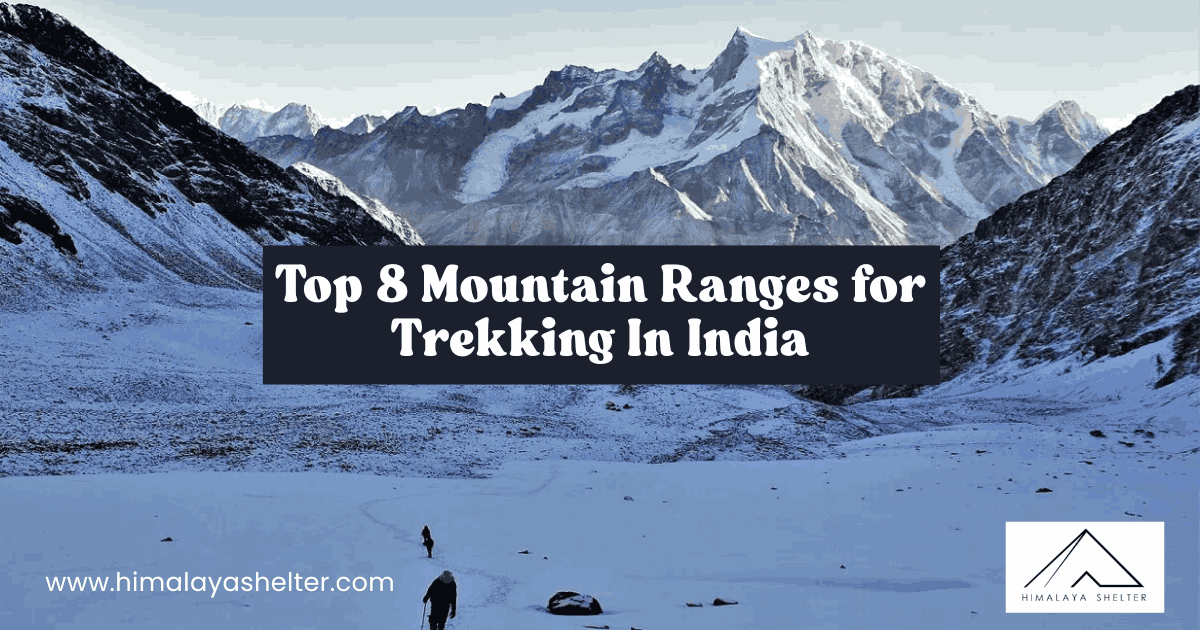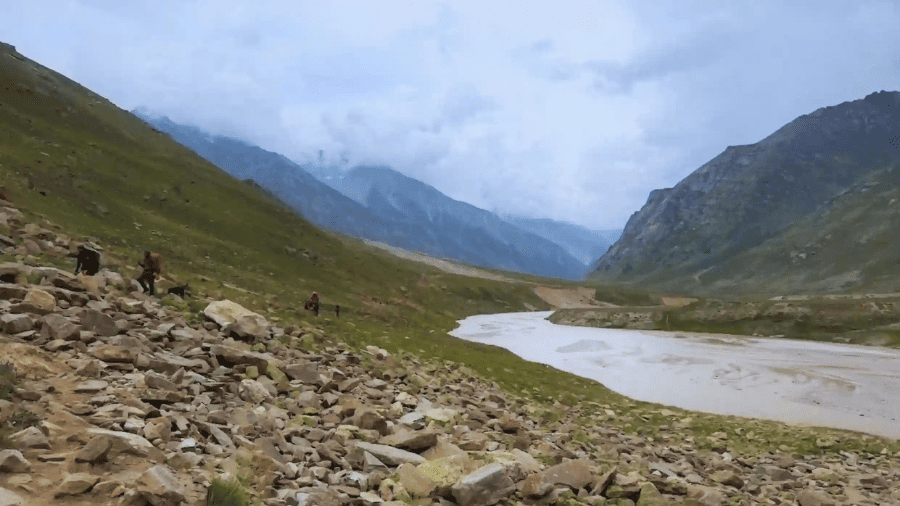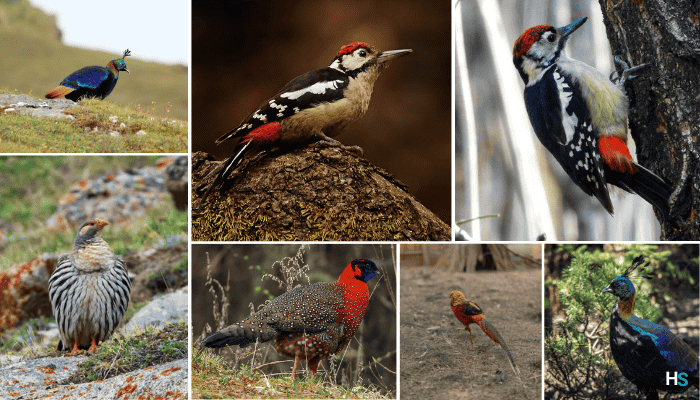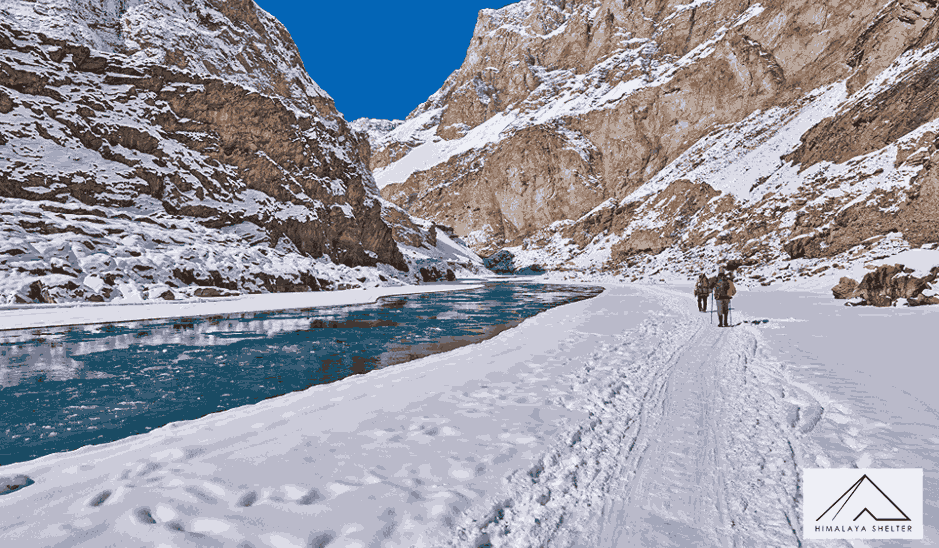
Top 8 Mountain Ranges For Trekking In India :
A secret ingredient is being added to trekking in India—the variety of mountain ranges. Each time you trek through India, it feels like entering a different country altogether. That’s the kind of adventure trekking in India offers.
The most well-known area is the Himalayan region, home to the majority of the world’s highest summits, including Everest, K2, and Kangchenjunga. However, India is also blessed with other prominent mountain ranges that are perfect for trekking and scenic journeys. These include the Satpura Range, the Vindhya Range, the Aravalli Range, and the Ladakh region.
Whichever mountain range you wish to explore, Himalayan Shelter is here to make your trekking dreams in India come true.
8 Mountain Ranges for Trekking in India
Pir Panjal Range
The Pir Panjal Range is a group of mountains in northern India’s Western Himalayas that are part of the Lower Himalayan region. The Dhauladhar and Pir Panjal ranges are gradually elevated in the Himalayas. It separates from the main Himalayan range close to the Sutlej River’s bank, creating a rift between the Chenab on one side and the Beas and Ravi rivers on the other. Two significant peaks at the eastern end of the mountain range are Deo Tibba and Indrasan. This mountain range contains six historic passes: Bairam Gala Pass, Banihal Pass, Pir Panjal Pass, Ratanpir Pass, Gulabgarh Pass, and Hajipir Pass. Pir Panjal is one of the famous trekking trips in India.
- Location: Jammu and Kashmir
- Altitude: Approximately 14,783 feet (4,500 meters)
- Famous Treks: Pir Panjal Valley Trek, Rohtang Pass, Bakhrot Valley Trek
- Best Time: May to October
Read: Ultimate 7-Day Guide to Exploring the Majestic Pir Panjal Valley
Dhauladhar Range
The Dhauladhar Range of mountains is situated in the Northern part of India. It is sometimes referred to as the Lesser Himalayas or the Outer Himalayas. To the north of Kangra and Mandi, it rises from the Indian plains. They start in the northwest Himachal Pradesh region of Dalhousie and travel through the state to the area around the Beas River in the Kullu district. The range’s elevation ranges from 3,500 meters to almost 6,000 meters. The Dhauladhar range is renowned for its untamed landscape, valleys, and majestic peaks. The U-shaped profiles and glaciated valleys of the Dhauladhar Range are also well-known features.
- Location: Himachal Pradesh
- Altitude: Approximately 14,783 feet (4,500 meters)
- Famous Treks: Triund Trek, Indrahar Pass Trek
- Best Time: March to June and September to November
Read: Top 14 Treks of Himachal Pradesh
Garhwal Range
Is hiking in India your first option? Then Uttarakhand is calling you! The upper portion of Uttarakhand is known as the Garhwal Himalayas, and it is bordered to the east by Tibet, to the northwest by Himachal Pradesh, and to the south by the U.P. state of Kumaon. The Garhwal Himalayas, which are tucked away among glaciers, deep valleys, river basins, and tall peaks, provide some of the best trekking experiences in the nation. The trekking trips in India has something for everyone, ranging from novice Nag Tibba to the challenge of Auden Col and Kalindi Khal Expedition for more seasoned applicants.
- Location: Uttarakhand
- Altitude: Peaks exceed 25,000 feet (7,620 meters)
- Famous Treks: Roopkund Trek, Valley of Flowers Trek
- Best Time: April to June and September to October
Must Read: Top 25 Treks in Uttarakhand Starting from Dehradun
Zanskar Range
Are you looking for adventure trekking in India? Then, this is your place! The Zanskar Range, which divides the Ladakh from Zanskar of Jammu and Kashmir. There, the peaks reach elevations of over 19,500 feet above sea level. The twin peaks Nun and Kun are the highest. The trek, which could take up to 20 days, will encounter numerous obstacles like ice walls, cliffs, slippery surfaces, icefall slopes, and glacial formations. The Buddhist monasteries in Zanskar are another reason for its fame. Halfway between Padum and Darcha is the most well-known, Phugtal Monastery. You will need to walk or ride a pony to get to the monastery.
- Location: Ladakh
- Altitude: Approximately 20,000 feet (6,096 meters)
- Famous Treks: Chadar Trek (Frozen River Trek), Stok Kangri Trek
- Best Time: January to February for Chadar; July to September for others
Ladakh Range
The Ladakh Range runs parallel to the Indus River between the city of Leh and the Nubra Valley. This area has peaks that are between 16,000 and 19,000 feet above sea level. Khardung La is the most well-known of the range’s high-altitude mountain passes. The entrance to the isolated Shyok and Nubra valleys is Khardung La, which is located north of Leh. The mountain pass is a popular location for tourists to take pictures of the stunning views due to its valley and winding roads. One of the simpler treks in Ladakh region is the Sham Valley Trek. The journey traverses the Sham region of Ladakh, passing through barley fields, streams, shaded willows, and small mountain passes.
- Location: Ladakh
- Altitude: Approximately 18,000 feet (5,486 meters)
- Famous Treks: Markha Valley Trek, Nubra Valley Trek
- Best Time: June to September
Read: Top 10 Treks in Ladakh
Karakoram Range
One of the largest mountain ranges in India is the Karakoram, which stretches through China and Pakistan, two of its neighbors. Named “the roof of the world” at times, the range is home to K2, the world’s second-highest mountain. Many of the locations in the Karakoram Range are still very difficult to reach because it is a sensitive border area. To reach the Indian peaks in the area, mountaineers need to obtain permits. Outside of the polar regions, the Karakoram Range is one of the most glaciated areas of the planet.
- Location: Northern India (partly in Pakistan)
- Altitude: Peaks over 28,000 feet (8,534 meters)
- Famous Treks: K2 Base Camp Trek, Baltoro Glacier Trek
- Best Time: June to August
Western Ghats
The vast Western Ghats stretch from Gujarat’s Satpura Range to Kanyakumari, India’s southernmost tip, a distance of roughly 5,250 miles (8,449 kilometers). The remarkable biodiversity in the Western Ghats is what sets them apart. Nearly 30% of India’s vegetation and fauna are native to the mountain range, which is a UNESCO World Heritage Site and one of the best hotspots for biodiversity in the world. There are a lot of national parks there as well. One of the most famous national parks in southern India is Periyar National Park in Kerala. To observe the park’s natural life, visitors can go on a watercraft safari. There are a lot of beautiful hiking in India options available here.
- Location: Western India
- Altitude: Peaks up to 8,842 feet (2,695 meters)
- Famous Treks: Ghats of Munnar, Kudremukh Trek
- Best Time: September to March
Shivalik Range
The Outer Himalayas are the most popular name for the Shivalik Hills. The plains and the Himalayan ranges are divided by the mountain range. The most popular tourist destination in this area is Rishikesh. Many ashrams or religious retreats can be held there, and it is regarded as the birthplace of yoga. There are also many adventure sports available to visitors, such as bungee jumping and river rafting. In the eastern Indian hill town of Kalimpong, West Bengal, visitors can enjoy a breathtaking view of Kangchenjunga, the third-highest mountain in the world. They can also go stream rafting in the Teesta River nearby. These are the most popular trekking trips in India.
- Location: Northern India
- Altitude: Up to 5,500 feet (1,676 meters)
- Famous Treks: Har Ki Dun Trek, Nag Tibba Trek
- Best Time: March to June and September to November
FAQs
Ans: The best mountain ranges for trekking in India include the Himalayas, Pir Panjal, Dhauladhar, Garhwal, and Zanskar ranges, among others.
And: The ideal time for trekking in India varies by region, but generally, it is from April to June and September to October to avoid monsoon rains.
Ans: Trekking difficulty levels vary widely, ranging from easy treks suitable for beginners to challenging routes that require advanced skills and experience.
Ans: Yes, many trekking routes in protected areas or near international borders require permits, especially in regions like Ladakh and parts of Uttarakhand.
Ans: Essential trekking gear includes sturdy hiking boots, weather-appropriate clothing, a good backpack, hydration systems, first aid kits, and navigation tools like maps or GPS devices.
Book your dream Trekking and Hiking Trip in India with Himalayan Shelter Now!!
About Author

Himalaya Shelter
Recent news

23 Dec 2025

20 Dec 2025

18 Dec 2025

16 Dec 2025

10 Dec 2025
Recommended Treks



Cost: ₹35000 | $405
Type: Moderate - Difficult
Best Time: July | August | September

Cost: ₹90000 | $1037
Type: Easy
Best Time: May to June and September to October

Cost: ₹42000 | $484
Type: Difficult
Best Time: May to June and September to October

Cost: ₹96000 | $1097
Type: Difficult
Best Time: May to June and September to October

Cost: ₹140000 | $1599
Type: Difficult
Best Time: April to June and September to October

Cost: ₹42000 | $480
Type: Easy
Best Time: April | May | June | September | October

Cost: ₹28000 | $320
Type: Easy - Moderate
Best Time: April to June and September to November






